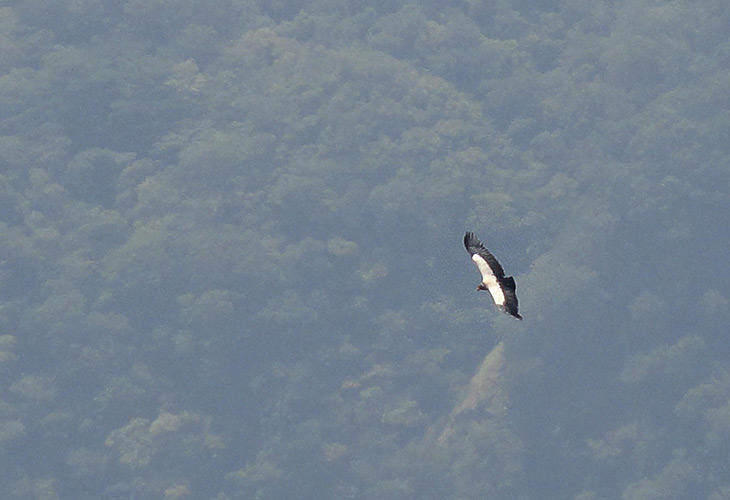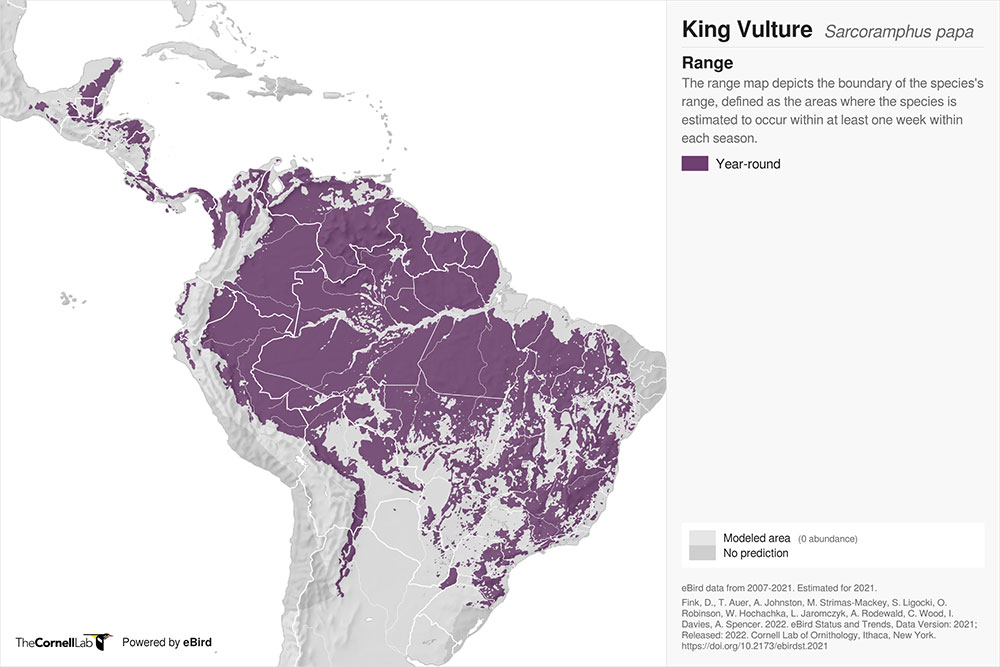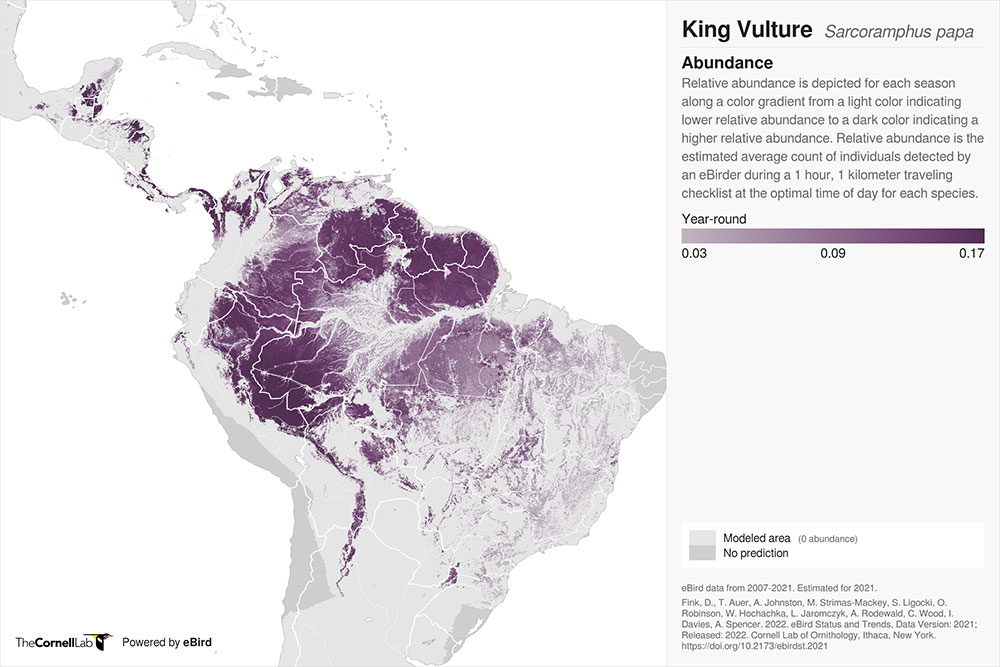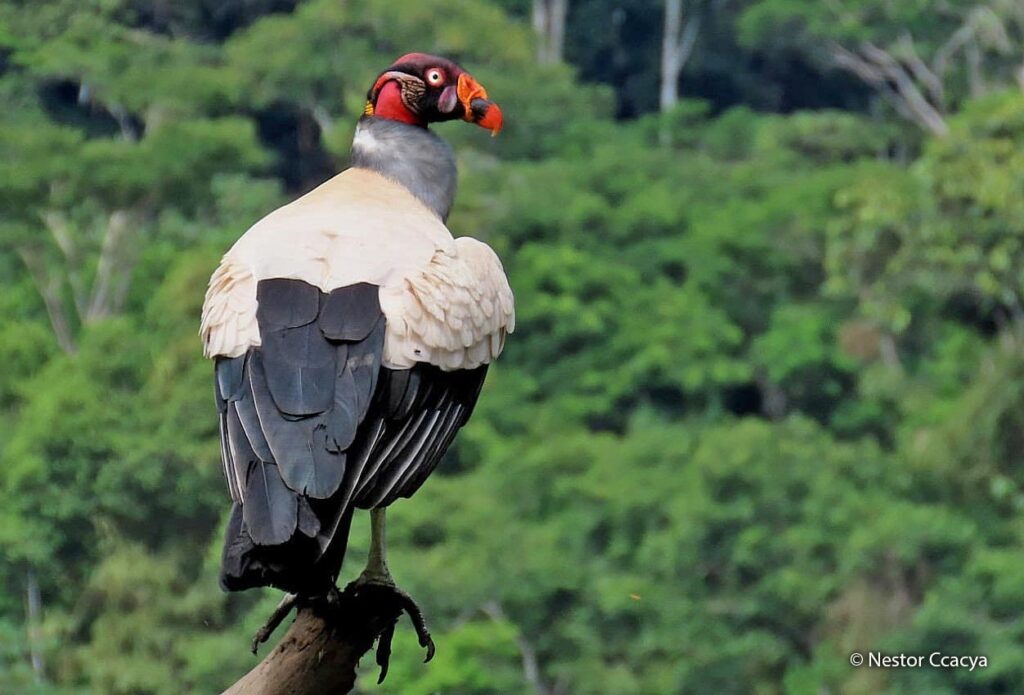In this article, I delve into the habitat used and the range where the king vulture lives. I cover the different habitat preferences and the current and historic range occupied by the king vulture. I also mention a brief overview of the conservation implications of one of the largest scavengers of the western hemisphere.

King Vulture’s Range
The King Vulture is an iconic bird exclusive to the Americas. It is found throughout the Western Hemisphere, from the dense rainforests of Mexico, Central, and South America to the subtropical woodlands of Brazil and Argentina.
The king vulture’s range is estimated to encompass approximately 14.3 million square kilometers.
Regarded as a symbol of undisturbed forest ecosystems, the king vulture’s presence is considered by some as an indicator of still untouched tracts of forest ecosystems.
Movements and migration
The king Vulture is primarily a resident species throughout its extensive range. This means that it is non-migratory and tends to occupy specific territories year-round.
As with other scavengers, the king vulture inspects huge areas in search of food, but these are not considered migratory movements but movements within its home range.
Altitudinal Range
Within its range, the King Vulture generally occupies lower elevations near sea level, but it can also occur at higher altitudes along the foothill of the Andes.
In the eastern slope of the South American Andes, the king vulture has been recorded locally at elevations as high as 2,500 meters. On rare occasions, they have been known to wander as far as 3300 meters of altitude.
This elevation is close to the treeline, where humid montane forests give way to alpine habitats and open grasslands.
This adaptability to varied altitudes allows the King Vulture to thrive in different ecological niches, utilizing both lowland forests and mountainous regions.

Historical Distribution
Over time, the historical range of the King Vulture has experienced changes.
Previously, these impressive birds were found as far north as Sinaloa on the Pacific slope and northern Veracruz or southern Tamaulipas on the Atlantic slope of Mexico. However, their current distribution is limited to Guerrero on the Pacific slope and southern Veracruz on the Atlantic slope.
Interestingly, there is even speculation that a closely related species, or possibly the King Vulture itself, once inhabited Florida and the southeastern United States in the 18th century.
King Vulture Habitat
The King Vulture lives mainly in pristine and undisturbed forests. It also occupies deciduous forests and semi-open woodlands.
It is generally regarded as a bird that avoids humans. However, in parts of its range, particularly in regions where large tracts of pristine forests are adjacent to human-created cattle and agricultural operations, the king vulture ventures out of the continuous forest to search for food in disturbed and human-created habitats.
King vulture habitats
Other than large tracts of undisturbed forests, the king vulture also spends time in other forest and habitat types.
As mentioned above, some ornithologists consider the king vulture a symbol of large extensions of virgin forest. King vultures are indeed well adapted to life in the canopy of the forest where it roosts and spend time, as well as life on the forest floor where it feeds and nest.
But king vultures are flexible in their habitat requirements and will use atypical habitats types that contain carrion.
In the humid Amazonian forests, they are observed at forest edges, river shores, and other openings. These are places where carrion, particularly carcasses of large animals, are more likely to be found.
King vultures also inhabit less dense, semi-open, deciduous, and disturbed forests in parts of its range. They also explore cattle ranches and agricultural land where livestock carcasses are likely to be found.
In northern Peru, the king vulture inhabits the semideciduous and deciduous forest of the extreme north tip of the country.

Food Availability influences where the king vulture lives
One of the key factors influencing the King Vulture’s habitat selection and where it spends most of its time is the availability of carrion.
While it typically avoids continuous agricultural and semi-urban areas, it has shown adaptability in certain regions. For instance, in Central America and parts of their range in South America king vultures regularly feed on carcasses within disturbed, deforested habitats, and cattle operations.
This flexibility in habitat use highlights their resilience in the face of changing landscapes.
Disturbed habitats may be used only for feeding purposes
In the preferred pristine forest habitat, such as the Amazonian forest, king vultures are known to roost in pairs perched in emerging trees. Here, they nest under fallen trees on the ground and large cavities in trees.

Little is known about their roosting and nesting habits in semi-open and disturbed habitats. It is likely that these habitat types are used only for feeding purposes, and king vultures fly long distances to return to their preferred roosting and nesting places in mature forests.
The handful of king vulture nests known have been found on the ground, large cavities of trees, and cliff ledges of largely pristine forests. No king vulture nest has been found in semi-open and disturbed habitats.
Conservation Implications
The vastness of the King Vulture’s range emphasizes the need for international collaboration and conservation initiatives to protect the diverse habitats it relies upon. Preserving the remaining forests and ensuring sustainable land-use practices are vital for safeguarding the continuous existence of this magnificent bird.
Conclusion:
The King Vulture lives mainly in mature and pristine forests, where it finds food and optimal breeding conditions. While it typically avoids agricultural and open areas, the species has demonstrated adaptability in certain regions, utilizing disturbed habitats when necessary.
The King Vulture’s range spans a large stretch of the Americas at varied altitudes. From Mexico to Argentina, these remarkable birds symbolize the beauty and biodiversity of the Western Hemisphere.
By understanding its habitat preferences within its vast range, we can contribute to the conservation of this awe-inspiring scavenger and the ecosystems it inhabits.